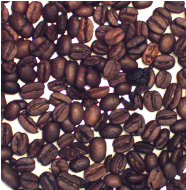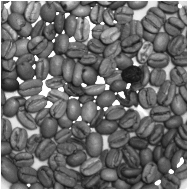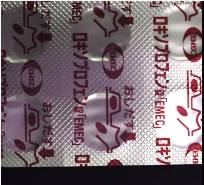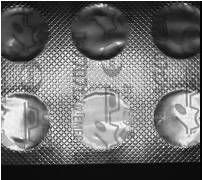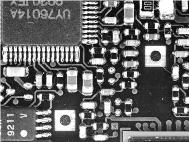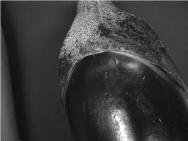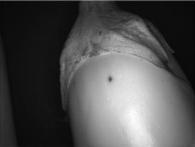|
||||||||||||||||||||||||||||||||||||||||||
|
||||||||||||||||||||||||||||||||||||||||||
Innovation: Clever multi-imaging using a one-lens, one-camera solution
JAI's AD 080GE steps into the breach
Above:
Jai AD-080GE.
Lens not supplied with camera
Generally most situations where imaging is required need one camera operating in the visible spectrum (roughly 400 - 700 nm). Sometimes however an application needs to utilise both the visible and near infrared spectrums at the same time and on the same subject. Often in these situations the application requires that for each pixel both the visible and near-infrared property is measured from exactly the same location - pixel correlated. Traditionally this is done using two separate cameras. This proves to be very cumbersome, difficult to integrate and expensive in time and budget dollars utilised. Two cameras with separate lenses and different optical axes make it virtually impossible to get perfect pixel matching between visible and infrared images for all pixels and so is a far from ideal solution.
Jai's AD 080GE one-lens, two-sensor camera has stepped into the breach and combined two cameras into one, while at the same time overcoming many of the disadvantages of using two cameras. The AD-080GE has made pixel correlated visible and Near IR capture affordable, reliable and easy-to-implement by producing concurrent images in both visible and near infrared spectra in pixel correlated alignment. More importantly, once set, this alignment remains true and does not need constant calibration.
 |
The Jai AD 080GE's prism technology in action The prism inside the AD-080GE camera splits the light in
two channels. The visible light channel captures the red, green
and blue bands of conventional imaging (the normally-coloured
apple at the top of the image). |
|
Previous, not-so-efficient, two-camera
solution |
The new JAI 2-CCD, one-camera solution |
| |
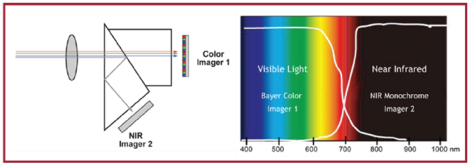 |
| Two cameras, synchronised, imaging one object. Impossible to get pixel correlated images on non-flat surfaces and very difficult to do so on flat surfaces. . | This approach not only eliminates the alignment issues of a two-camera system, but it is easy-to-deploy and avoids the extra cost of two cameras, lenses, cables, etc. |
Why is the JAI AD 080GE one-camera
solution different?
Two progressive-scan sensors are mounted to a custom-designed optical
prism. The manufacturing process precision-bonds the sensors onto a customised
prism optic. Jai have developed their own proprietary equipment and processes
to align and mount sensors to the prism accurately and reliably and are
one of the very few camera companies around the world able to do so. The
visible sensor is a Bayer RGB CCD sensor and is the matching colour version
of the mono sensor used on the near-infrared channel so all mechanical
and spatial characteristics of the two sensors are identical. A custom
designed multi-faceted prism supports the sensors and is placed in the
cameras optical path directly behind the lens mount. Each channel of the
prism is fitted with band-pass filters. This unique 2CCD process opens
up a very wide range of capabilities and Jai have already released the
AD-081GE which offers extended dynamic range with 2x mono sensors.
How can Jai's unique design benefit my situation
The AD 080GE offers pixel correlation, something 2 cameras cannot offer.
It can also save set-up and operating time, equipment and cabling costs.
In addition, the inclusion of GigE output means:
** increased bandwidth for higher performance
** increased versatility as there is no need for specialised frame grabbers
** longer cable lengths
Jai's AD-080GE opens up the possibility for new applications or for optimising
existing applications. For example it is able to view surface properties
in the colour channel while simultaneously viewing just below the surface
in the near-IR channel. A typical application for this capability is the
inspection of fruit and vegetables where bruising under the surface cannot
be detected with visible light but is clearly viewed in the image from
the NIR sensor (see above) while simultaneously discerning
the colour of the fruit. The ability to correlate, exactly, pixels in
both colour and NIR images is impossible to do, consistently, with two
separate cameras.
Other applications include the inspection of thin-screen printed plastic
packaging while concurrently inspecting the contents of the packaging;
applications in textile-defect detection, aerial mapping, print quality
inspection and many others. Some examples follow.
Read
more about the applications, benefits and advantages
of the JAI AD 080GE or to read
specifications and download datasheet
| Adept Electronic Solutions are 'The Machine Vision and Imaging Specialists and distributor for Jai products in Australia and New Zealand. To find out more about the Jai Camera options or any Jai product, please email us at: adept@adept.net.au, call us at Perth (08) 92425411 / Sydney (02) 99792599 / Melbourne (03) 95555621 or use our online contact us form. |
|
If you like this page, please recommend and share it. |
|||
| More | |||





